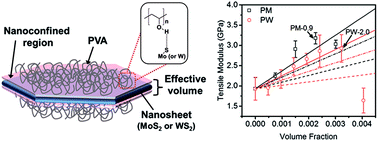Anomalous nanoinclusion effects of 2D MoS2 and WS2 nanosheets on the mechanical stiffness of polymer nanocomposites†
Abstract
Polymer inorganic nanosheet composites hold great promise in enhancing their physical and mechanical properties by increasing the interfacial area. Herein, we demonstrate the nanoinclusion effects of two-dimensional (2D) molybdenum disulfide (MoS2) and tungsten disulfide (WS2) nanosheets on the mechanical properties of the poly(vinyl alcohol) (PVA) polymer. At very small amounts of nanosheets (0.9 wt% for MoS2 and 2.0 wt% for WS2), nanocomposite films exhibit up to 65% improved mechanical properties than the neat PVA film because of strong non-covalent polymer–filler interactions by means of large contact area induced by the 2D geometry of nanosheets. As demonstrated by the decrease in the crystallinity of PVA and the increase in the glass transition temperature, 2D MoS2 is a more attractive filler than 2D WS2 in terms of reinforcing mechanical properties of PVA. These findings fit well with a modified Halpin–Tsai (H–T) model including a nanoscale interfacial layer that can support the observed reinforcements with extremely small 2D filler loadings. This study highlights the strong interplay between the polymer and inorganic nanosheets which plays an important role in greatly improving the mechanical stability of nanocomposites.


 Please wait while we load your content...
Please wait while we load your content...